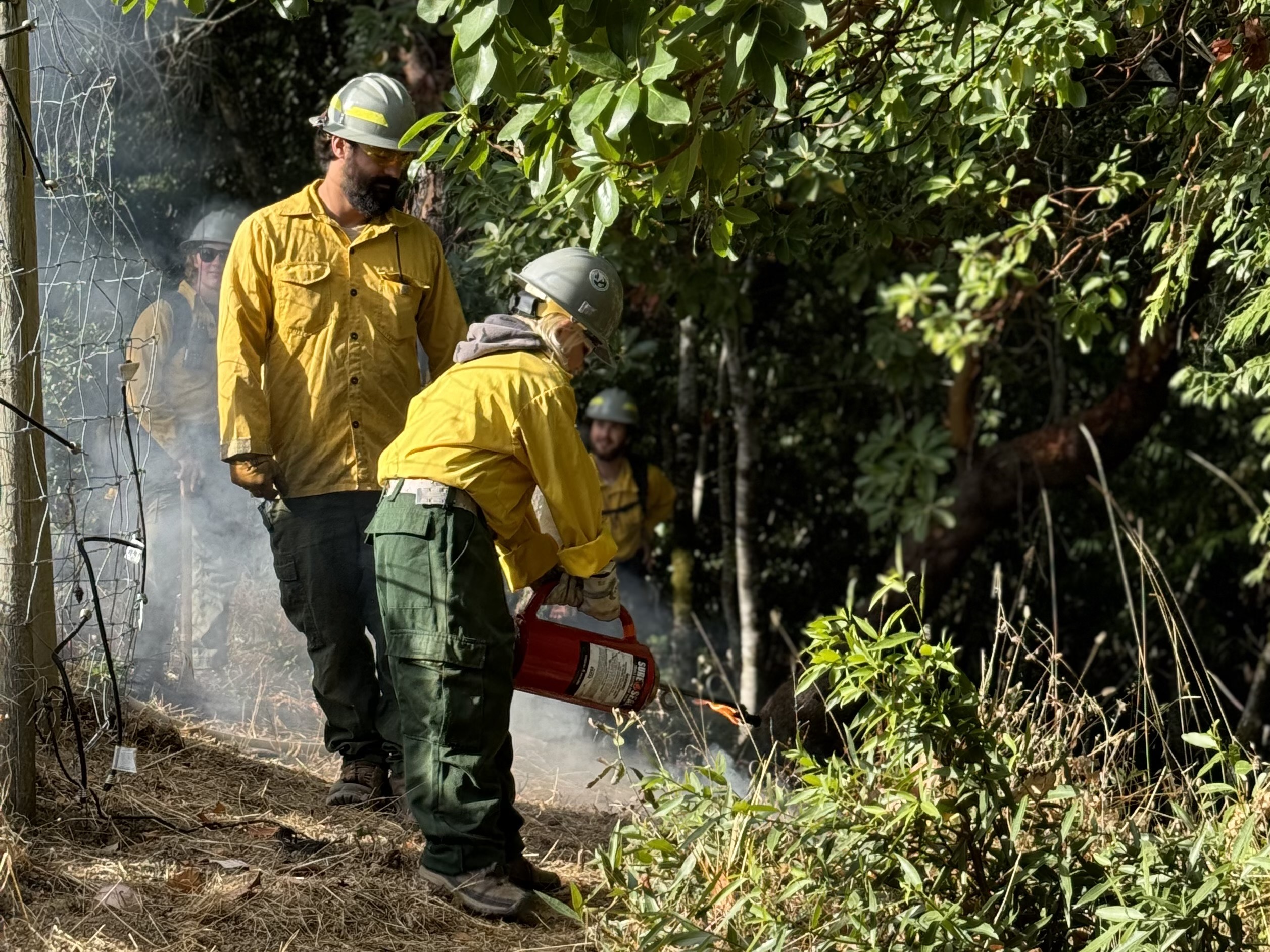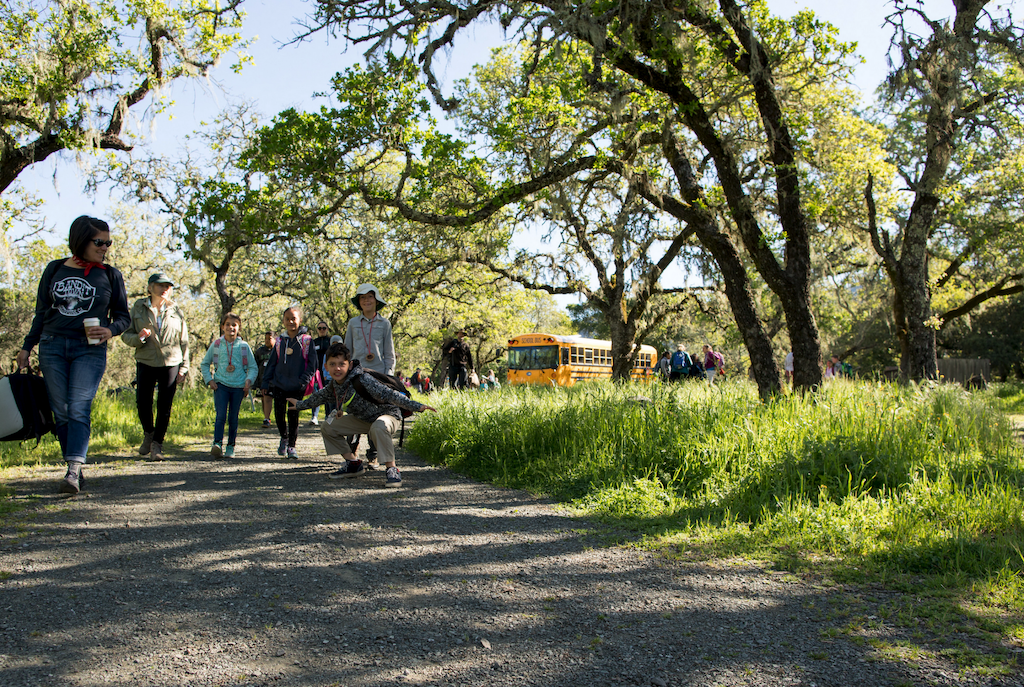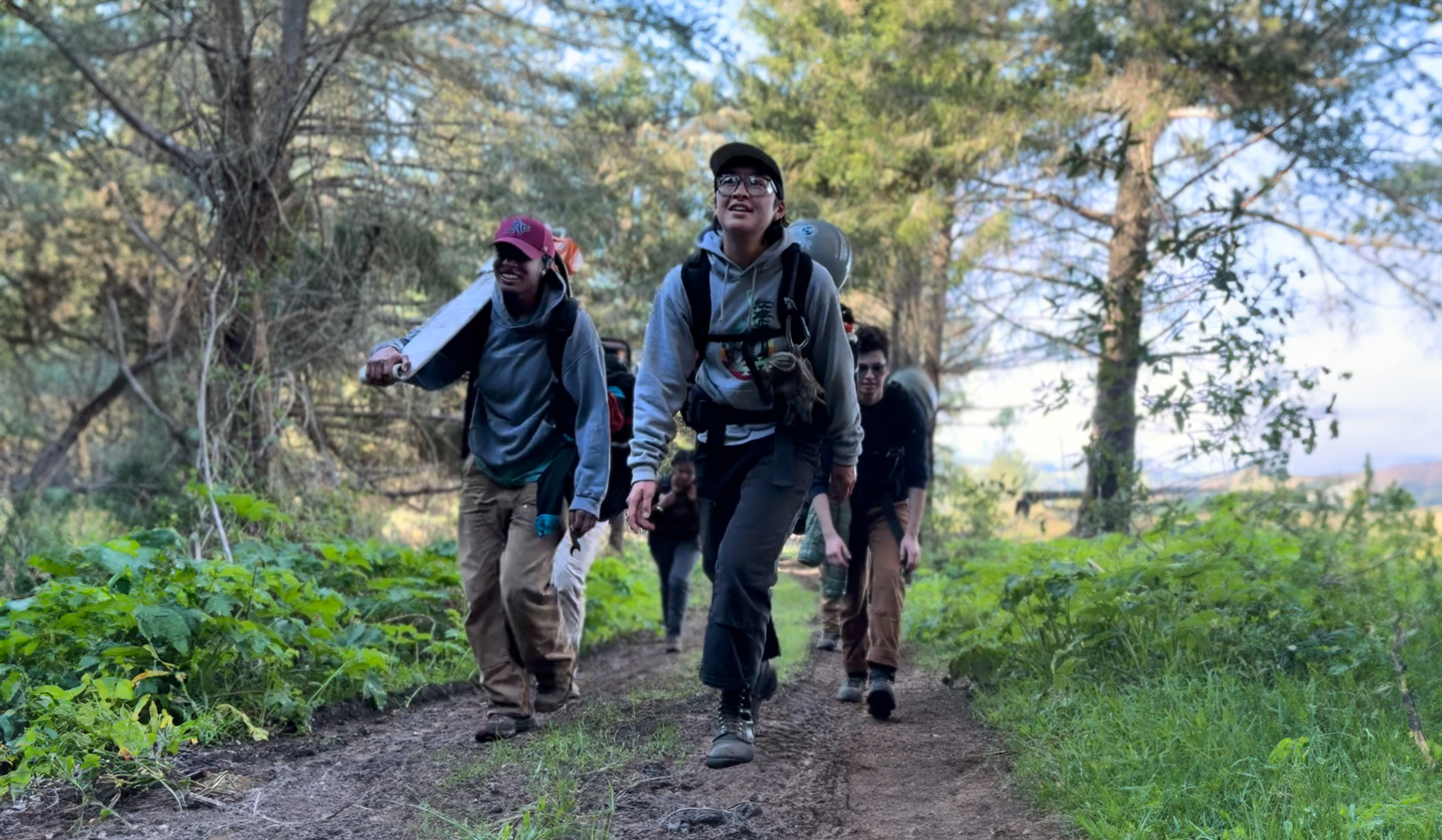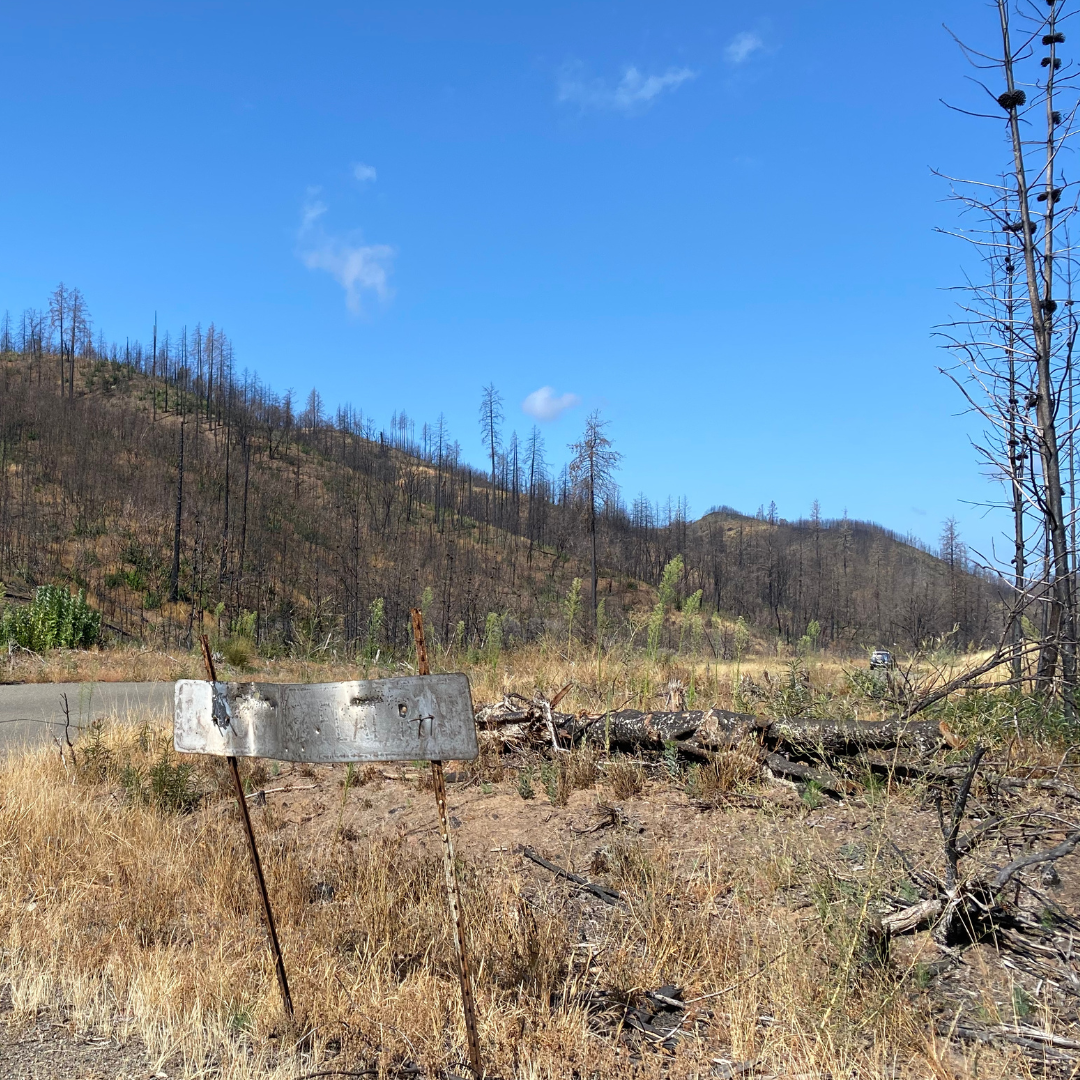|
Getting your Trinity Audio player ready...
|
An intentional return to fire
Thomas Creek Ranch, a tight-knit community on the Russian River, sits on ancestral Southern Pomo territory. In mid-October 2023, a small creek offers seasonal flow to the plant community of California bay laurels, Douglas firs, black oaks, and madrones. The air is musky with damp duff, punctuated by the raucous cackle of crested jays and acorn woodpeckers.
Formed in 1974 by five families, the residents of Thomas Creek Ranch shared a back-to-the-land dream of creating shared spaces for connecting over meals prepared from their community garden. The 12 families who now cooperatively own the land have committed to becoming more fire-wise and better stewards by reintroducing beneficial fire to their habitat.
Bringing good fire back to the land meant that the families involved needed to unpack their fear of fire and then, assess where and how to begin. While they knew that fire played a role in the ecosystem, they had never been part of a prescribed broadcast burn. Alan Siegle, resident of Thomas Creek Ranch who spearheaded the burn effort, understood the paradigm many rural residents face.
“We had always done land maintenance, but never prescribed burning. We build safe spaces around buildings, do burn piles with permits, but never considered the prospect of prescribed burns. We didn’t have any previous skill in doing it and would have never felt comfortable doing it on our own. After seeing the expertise and detail that went into it, now I understand why.”
– Alan Siegle
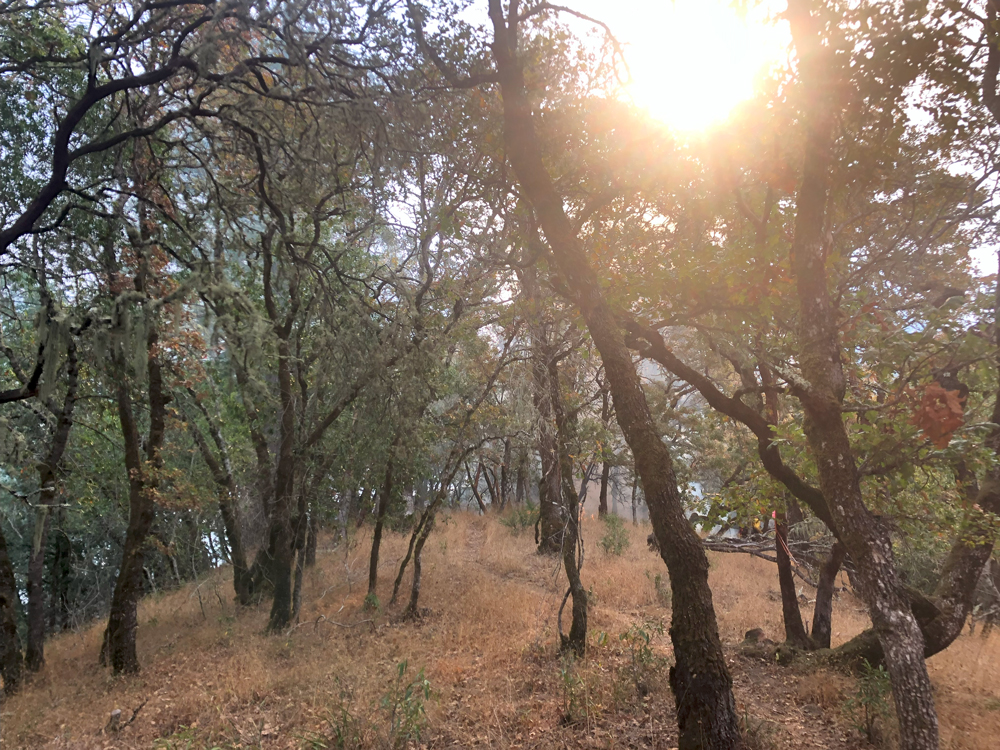
A dangerous accumulation of woody debris in a fire-adapted forest
This wooded pocket, like much of the region, hasn’t been intentionally stewarded with beneficial fire in more than 100 years — a stark contrast to fire-dependent adaptations of these ecosystems stewarded by Indigenous communities for thousands of years. Now residents are facing the dangerous accumulation of woody debris and the declining health of an ecosystem dependent on regular intervals of fire.
Timing was also a concern, due to underlying fears activated by wildfire memories. For many residents, October holds the anniversaries of many haunting wildfires in recent years. Only three years prior, the Walbridge burned toward the community for 46 days, coming just a few miles shy of Forestville.
“As most people in Forestville, we were very concerned about fire. It struck a chord after the wildfires in 2017 and then 2019 and then again in 2020… that last one really got our attention. Ever since then we’ve been doing work on our own, but there’s only so far you can get.” – Alan
Responding to fear of fire
While the Thomas Creek Ranch community was ready to reintroduce fire to the landscape, not all nearby neighbors were. Otis Holt’s home borders the Thomas Creek Ranch community at the top of a steep ridge. At the time the burn was first proposed, he was reluctant to the idea of fire near his home.
“In those first visits with Garrett and Sasha, they stressed this isn’t just a question of dealing with fire mitigation with a prescribed burn, it’s also community building process.” – Alan
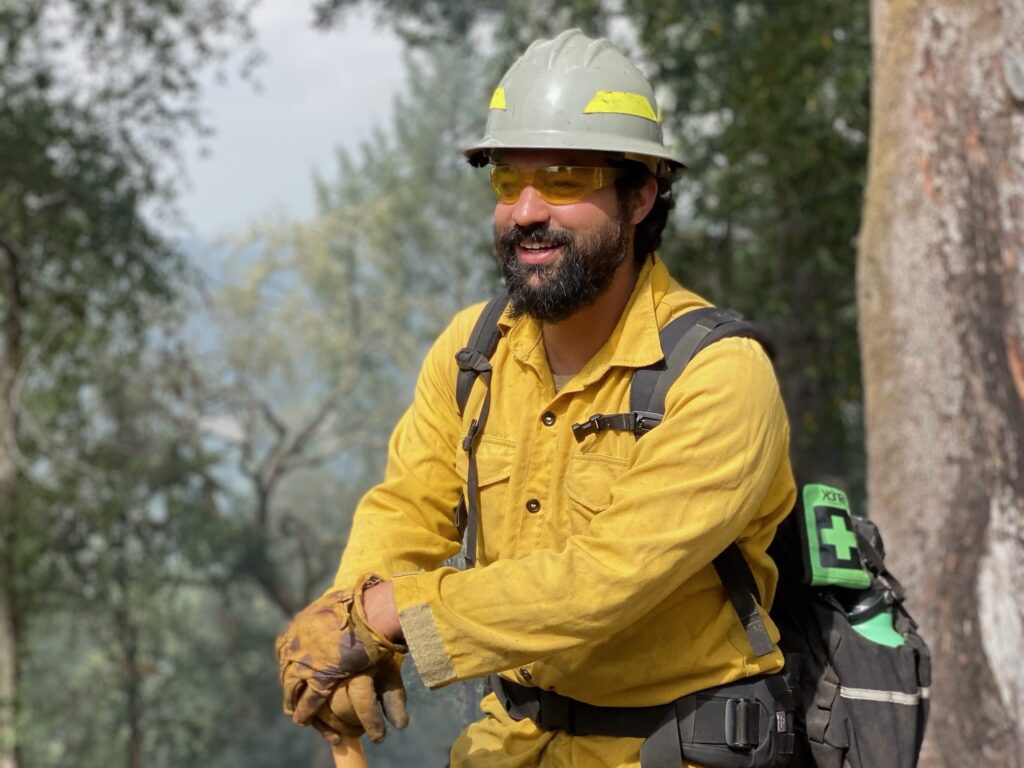
Bridging intersecting communities
In early 2021, Alan came to Fire Forward to request help from program director Sasha Berleman and training programs coordinator Garrett Gradillas. Alan understood using prescribed fire increases wildfire safety, reduces hazardous fuels near homes, and improves woodland health for diverse plant and animal habitats. Sasha and Garrett recognized finding the right person to lead this process could be a mutually supportive learning experience for the people who would eventually come together to support the burn.
At the same time, local land steward Asa Voight was participating in a unique prescribed fire fellowship offered by the Fire Forward program. Asa needed field experience to certify as a California Prescribed-Fire Burn Boss (CARX), a qualification that would support his leadership of prescribed burns on private lands.
Asa, who grew up in Forestville, is known to colleagues for his grounded nature and his dedication to influencing a culture of stewardship and reciprocity. His intimate knowledge of the ecology of land and tributaries, paired with a commitment to cultivating relationships in his hometown community allowed him to understand and answer the many questions that Thomas Creek Ranch residents had about the role of fire in stewardship.
Stewarding land and people with good fire
With the support of Sasha, Garrett, and a deepening network of fellows, Asa spent the next two years preparing both the unit and community for the burn. During that time, Asa also helped develop and lead Santa Rosa Junior College’s Wildfire Resiliency Program (WRP) at nearby Shone Farm. The program was designed to mentor and train local land stewards to increase community safety and steward ecosystems toward resilience.
“I believe we not only need stewardship of land through good fire, but also stewardship of people through good fire. That became a major theme of this burn. Leadership was represented by individuals from many local organizations, all coming together to make this a positive and productive experience for both people and land.”
– Asa Voight
It takes a lot of leadership to come together for a prescribed fire event. Audubon Canyon Ranch, Sonoma Land Trust, Tribal EcoRestoration Alliance, Laguna de Santa Rosa Foundation, Pepperwood, and CAL FIRE were represented on the Thomas Creek Ranch burn. With experienced leadership in position, Asa assigned crews of WRP students paired with seasoned mentors.
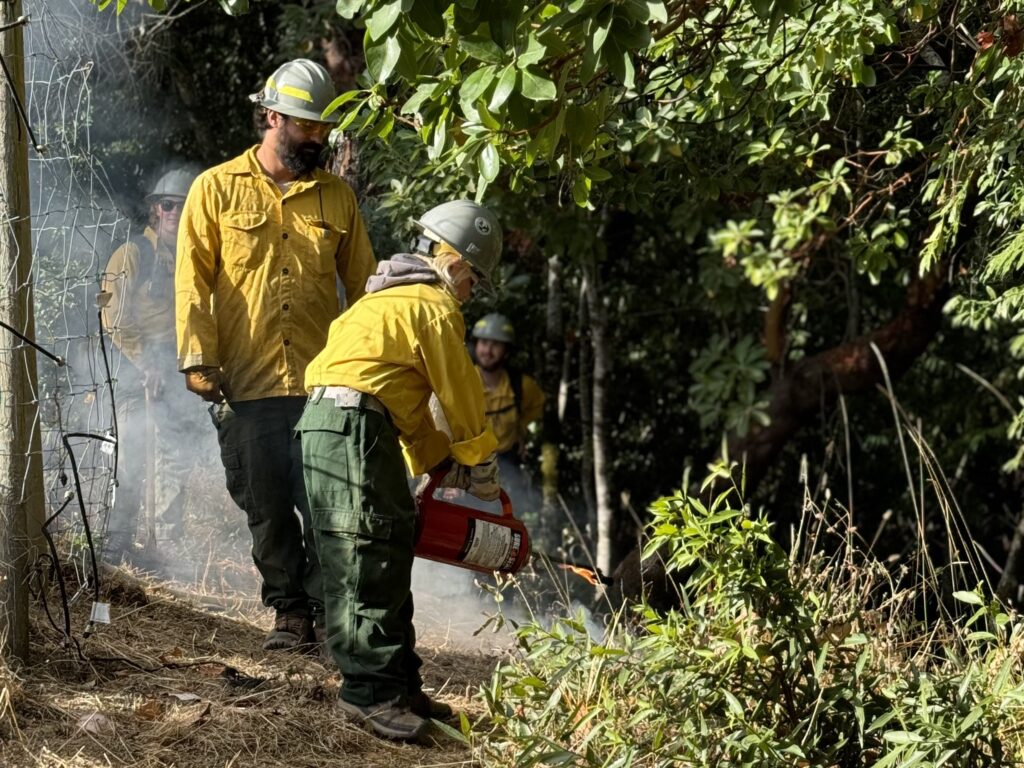
Passing the torch
The smallest and youngest volunteer, 11-year-old Alex Akre, nervously arrived in oversized Nomex and leather gloves clipped to his belt. Alex knows Asa as a trusted friend and mentee of his mother, Sarah Gordin. Asa invited them to join the supervised experience, knowing that like many kids in Sonoma County, Alex has been heavily impacted by wildfire-induced fear and anxiety.
Alex’s associations began as a 5-year-old living in Kenwood, when the family was awakened in the middle of the night to flee the Nuns Fire in 2017. He remembers packing his cat in the car and rushing away, not knowing if he’d ever see home again. The following years of red flag warnings and recurring evacuations brought Alex to the point he would shut down when he heard sirens or smelled smoke.
“When Asa first brought this up, I was completely shocked. It never occurred to me that Alex could be part of this. I mean he’s a kid, right? I just immediately thought about what this could potentially mean for his healing process…” – Sarah Gordin
After the test fire was lit, many of the burn leads and residents of Thomas Creek Ranch made a point to introduce themselves to Alex. Sarah expressed gratitude for their willingness to pass the torch to her young son.
“Lighting that test fire is an honor. I know that the landowners gave up their place to do that for him. And Alex knew that too, he could feel that. He found his courage, but he also found his own power in that moment.
It was this perfect moment. Just afterward, Alex came up to me with the biggest smile and said, ‘Mom! I’m not so afraid of fire anymore!’ And I thought… me too. That’s why we’re here.”
– Sarah
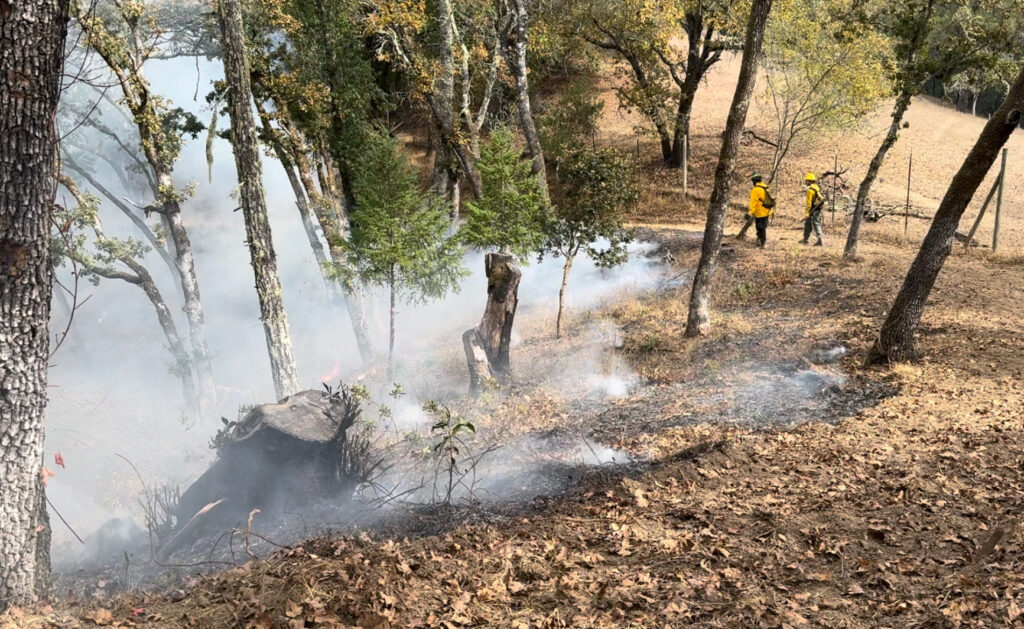
Seeding positive relationships to fire
By the time the burn was implemented, Otis became a major advocate of the project, and his property was incorporated into the plan. He beamed as he showed Alex the bags of fire-adapted native grass seed he planned to scatter into the soil, rich with warm carbon. He now sees the prescribed burn as an opportunity to clear priority hazards beneath his house that he couldn’t have done easily on his own.
“I was deeply impressed by the teamwork and sheer dedication. It’s clear this burn was comprehensive in ways I never knew. Now I can do winter pile burns safely because the surrounding areas have been cleared.” – Otis

Lasting benefits emerge from the experience
The day ended gathered around bonfire pits with a buffet of crockpot chili, cornbread, and hearty sighs of relief. Thomas Creek Ranch residents marveled at their first prescribed burn and swapped impressions with their new extended community of neighbors, students, and fire practitioners.
“Asa’s design of the burn unit required expertise and skill. As a result of that plan we built check lines and control lines for the burn. That took quite a bit of time, but it also created a network of new hiking trails that the community has been enjoying since then. If more people were aware of the effort and planning to do one of these, there would be less public concern about it getting out of control. There were so many safeguards in place we would have never even thought of.”
– Alan

The courage to learn together
With the completion of this burn, Asa is eligible for CARX Burn Boss certification and already thinking ahead to the next burns he could lead at Thomas Creek Ranch. He considers it a success that his assignment had come full circle, knowing he supported building a gentler relationship with fire for everyone involved in the process.
“The generosity of the Thomas Creek Ranch community was so inspiring. We wouldn’t have been able to do any of this if it was not for them. So many students were able to have a positive experience with fire on the land because the community demonstrated the courage to learn together.”
– Asa
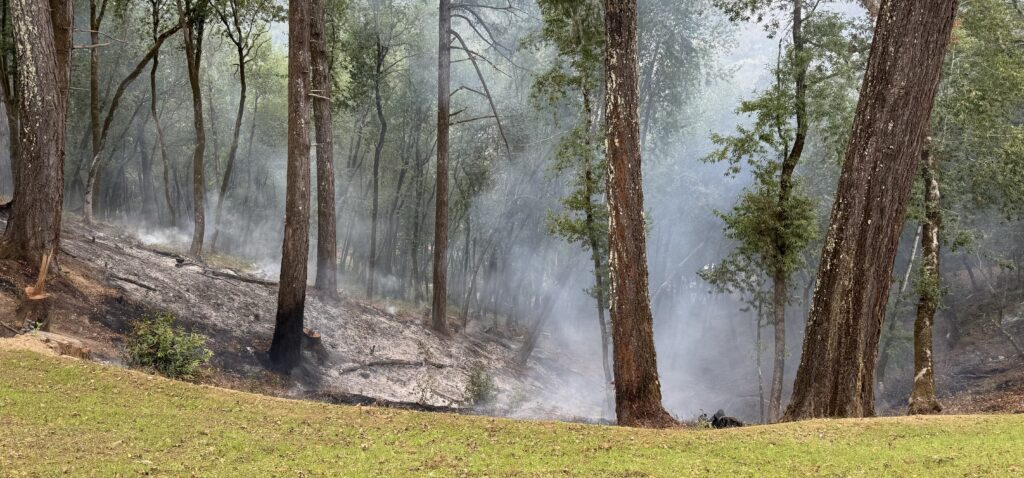
Stewarding with fire: Is prescribed fire right for you?
Audubon Canyon Ranch launched its Fire Forward program in 2016 to bring together private landowners, public agencies, and conservation partners around a shared purpose of stewarding ecosystems and reducing the impact of wildfire. We provide expertise, advice, and on-site support to help you achieve your stewardship objectives. If prescribed fire is a good fit for you and your land, we will connect you to the training, tools, prescribed fire managers, and skilled community volunteers to make it happen.
Learn more about building resilient communities by bringing good fire to your land >
